Alloy Chain Sling Assemblies: Parts, Configuration, and Terminology
We often find there is confusion around the different terminology used to describe alloy chain slings. In this article, we'll look at the different parts of a chain sling and some of the terminology used to classify different chain sling assemblies.
Maybe your company is looking to replace some of your slings with chain, and you want to learn more about what makes up a chain sling assembly. If you’ve purchased a chain sling before, you may have noticed that the item is referred to with an acronym on the order or quote.
It’s not uncommon to receive a quote or a periodic inspection report that’s filled with abbreviations that you don’t understand. We often find that customers aren’t aware of the many configurations that chain slings are available in and how to properly refer to them.
Before you order a chain sling, it is helpful to understand:
- The parts of a chain sling assembly
- How they are named and what the acronyms mean
- The different available configurations
Parts of a Chain Sling Assembly
Chain slings are one of the most durable lifting slings on the market. In addition to their durability, their main attraction is that, unlike other types of lifting slings, chain slings are adjustable.
The acronyms used in chain sling abbreviations are defined by the parts present on the sling assembly. So, before we explain how to correctly abbreviate the name of a chain sling, we want to clarify what the different parts are.

A chain sling assembly may have one, two, three, or four legs. Each chain sling has one upper end fitting and, depending on the number of legs, one, two, three, or four lower end fittings.
On multiple-leg sling assemblies, the individual legs are attached to each other using a collector ring as the upper end fitting. Lower end fittings on the end of each sling leg are used to connect the sling to the load, which are typically a type of hook.
Each chain sling, like every other sling, is required to have an identification tag. If, during the course of a chain sling inspection, the identification tag is found to be missing, the sling should be removed from service.
Identification Tag
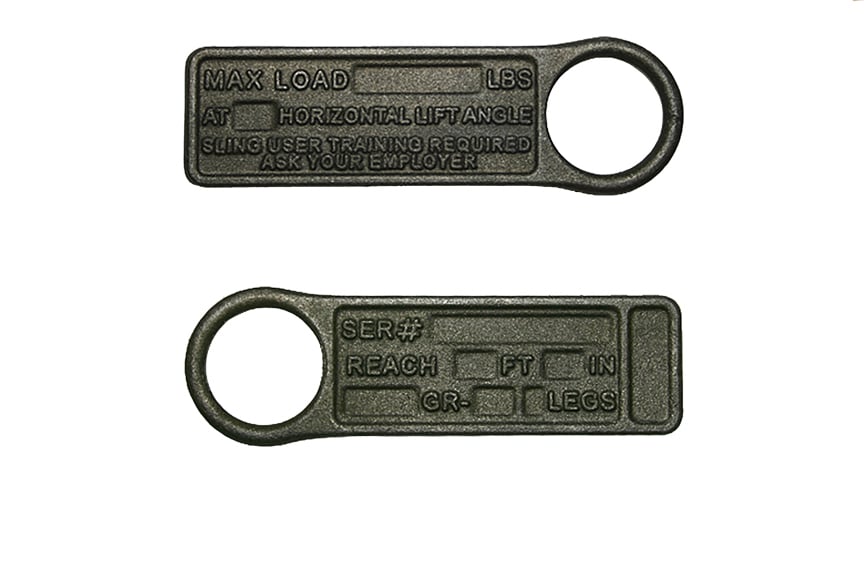
Any sling used for overhead lifting is required to have an identification tag. According to ASME B30.9 – Slings, each chain sling shall be marked to show:
- Name or trademark of manufacturer, or if repaired, the entity performing repairs
- Grade
- Nominal chain size
- Number of legs
- Rated load for at least one hitch type and the angle upon which it is based
- Length (reach)
- Individual sling identification (ex: serial number)
Upper End Fittings
At the top of a multiple-leg chain sling assembly, the upper end fitting is a collector ring—also referred to as a collector link, master link, or master ring. The link “collects” all of the sling legs and allows the sling assembly to connect to the crane hook or other part of the rigging.
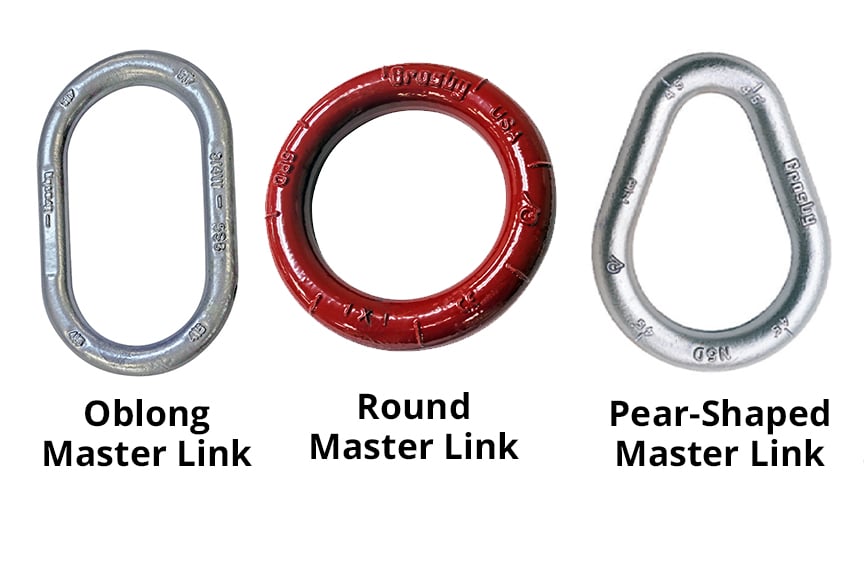
The collector ring may be an oblong master link, round master link, or a pear-shaped link. However, it is most common to see an oblong master link as the collector ring on a chain sling assembly.
On a single-leg chain sling assembly, the upper end fitting may either be a collector ring or a type of hook.
Chain Sling Legs
A chain sling may have one, two, three, or four legs attached to the collector ring. Single leg slings may have a hook on each end, rather than a collector ring as the upper end fitting.
Lower End Fittings
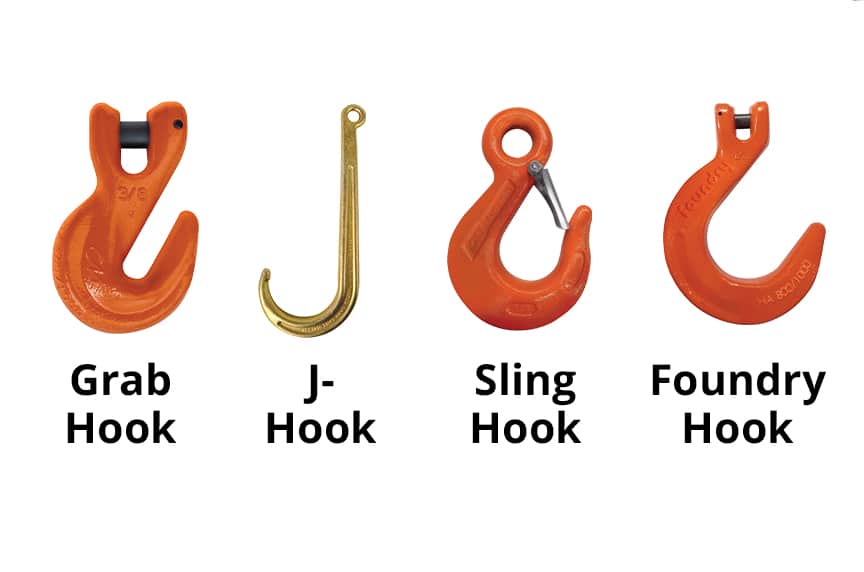
More often than not, the lower end fittings at the end of each chain sling leg will be hooks. The most commonly used types of sling hooks on a chain sling assembly are:
- Sling hooks
- Grab hooks
- Foundry hooks
- J-hooks
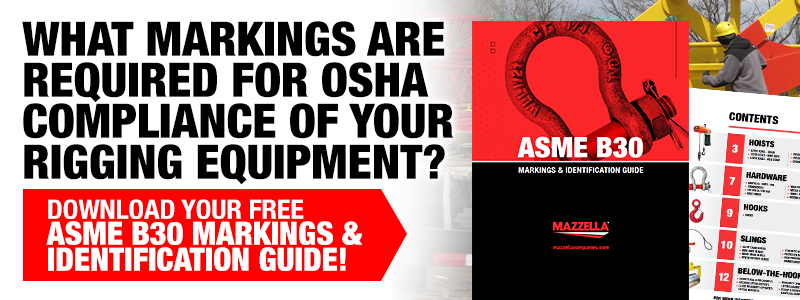
Chain Sling Terminology
On an order or product number, you may see a chain sling referred to as a series of three to four letters. These letters form an acronym that stands for the parts and configuration used in the assembly. Here is a breakdown on what each letter stands for:
- First letter = Number of sling legs
- Second letter = Upper end fitting
- Third letter = Lower end fitting(s)
- Fourth letter = Presence of adjusters
First Letter: Number of Sling Legs
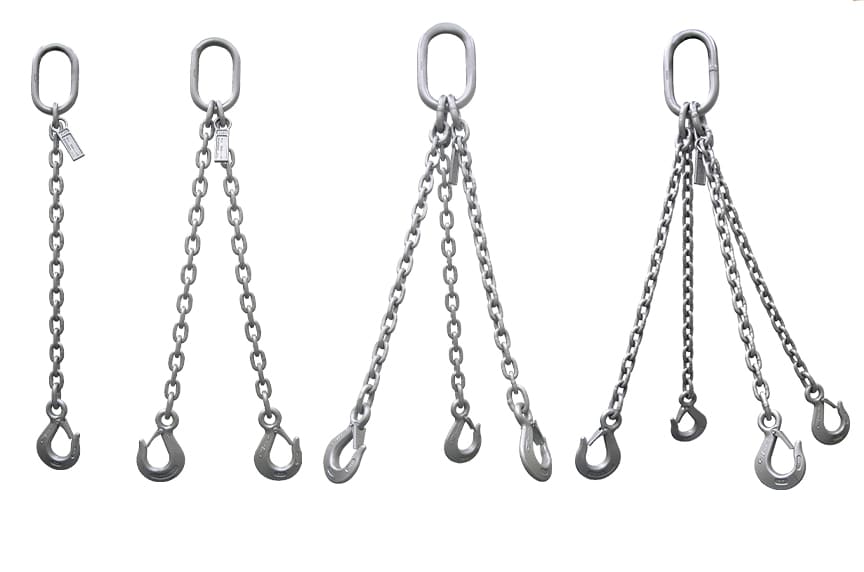
A chain sling assembly may have anywhere from one to four sling legs. The letter for this will be one of the following:
- S = Single (1)
- D = Double (2)
- T = Triple (3)
- Q = Quadruple (4)
Second and Third Letters: End Fittings
The second letter in a chain sling’s acronym represents the upper end fitting while the third letter represents the lower end fitting(s).
As we mentioned above, a single leg sling may have both an upper and a lower end fitting as a hook. Multiple-leg chain slings will have some sort of a collector ring as the upper end fitting.
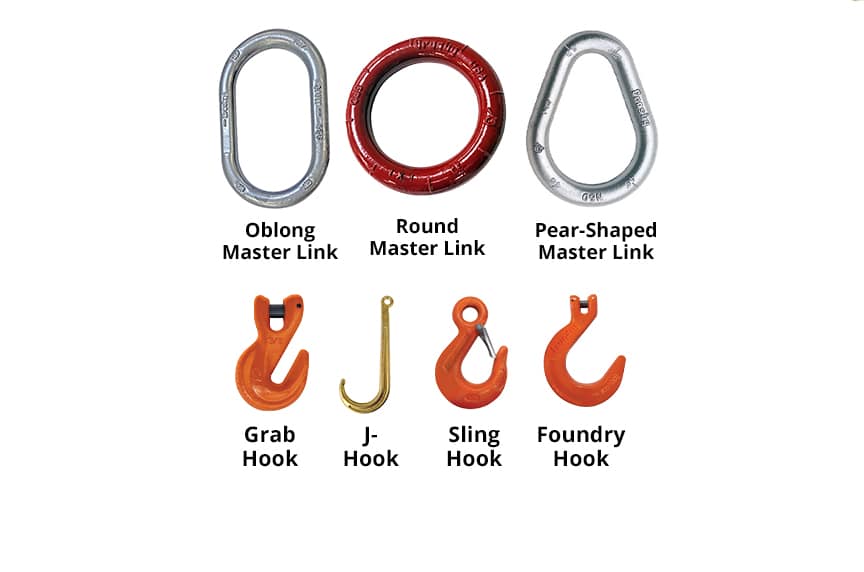
The second and third letters will each be one of the following:
- O – Oblong link
- P – Pear-shaped link
- R – Round master link
- S – Sling hook
- G – Grab hook
- F – Foundry hook
- J – J-hook
Fourth Letter (if applicable): Adjusters
The fourth letter represents the presence of adjusters on a chain sling assembly. Adjusters are an optional add-on for a chain sling assembly, so the fourth letter is not always necessary in determining the acronym.
The adjusters—usually grab hooks—may hang directly off the collector ring or they may be found at the end of a short length of chain.
If there is a fourth letter, it will be one of the following:
- A = The adjuster hangs about 2 inches below the collector ring
- B = The adjuster hangs from a length of chain more than 2 inches below the collector ring
Chain Sling Configuration Examples
In this section we’ll review some possible different chain sling configurations and the proper acronyms for each.
Single-Leg Chain Sling Configurations
As mentioned above, single-leg slings may have either a hook or a collector ring as the upper end fitting. Let’s go over some examples (see labeled image for number references).
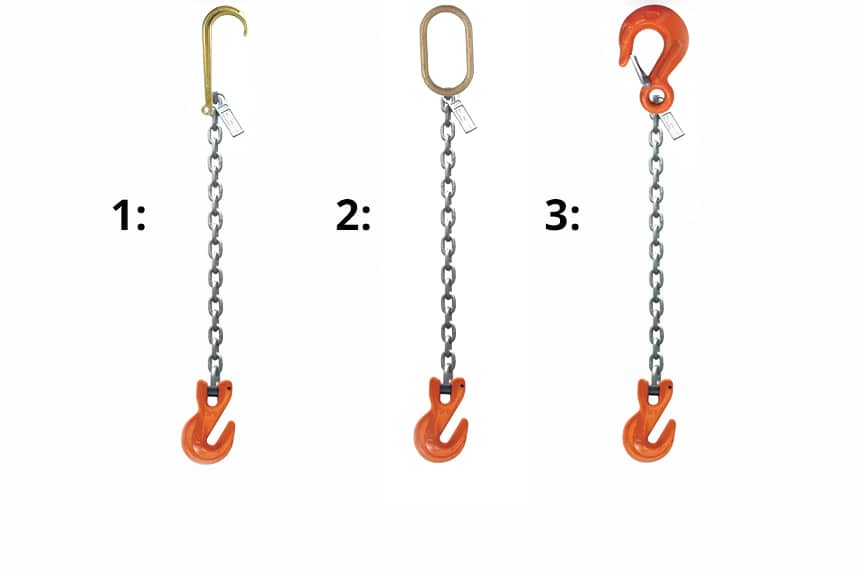
#1 SJG Chain Sling
S – Single-leg
J – Upper end fitting is a j-hook
G – Lower end fitting is a grab hook
#2 SOG Chain Sling
S – Single-leg
O – Upper end fitting is an oblong master link
G – Lower end fitting is a grab hook
#3 SSG Chain Sling
S – Single-leg
S – Upper end fitting is a sling hook
G – Lower end fitting is a grab hook
Double-Leg Chain Sling Configurations
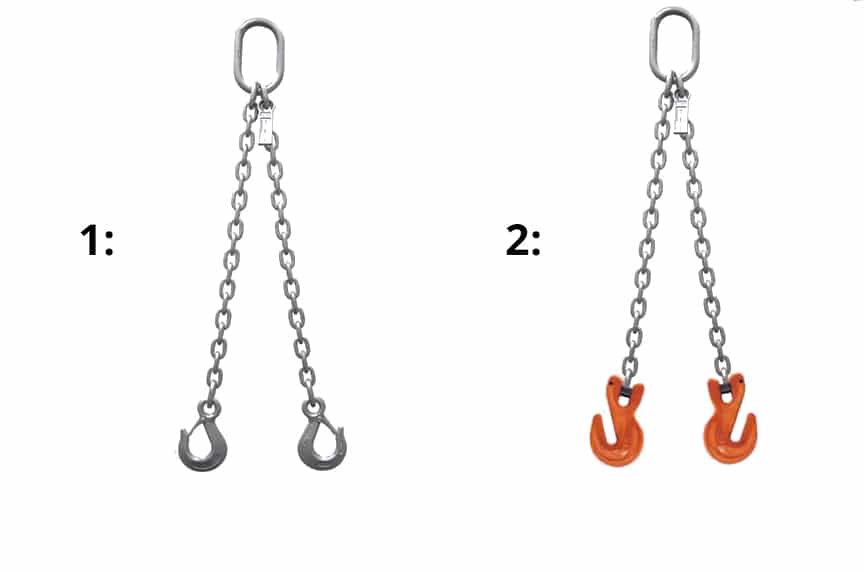
Double-leg chain slings, like all multiple-leg chain slings, will have a collector ring at the top. Let’s go over some examples (see labeled image for number references).
#1 DOS Chain Sling
D – Double-leg
O – Collector ring is an oblong master link
S – Lower end fittings are sling hooks
#2 DOG Chain Sling
D – Double-leg
O – Collector ring is an oblong master link
G – Lower end fittings are grab hooks
Triple-Leg and Quadruple-Leg Chain Sling Configurations
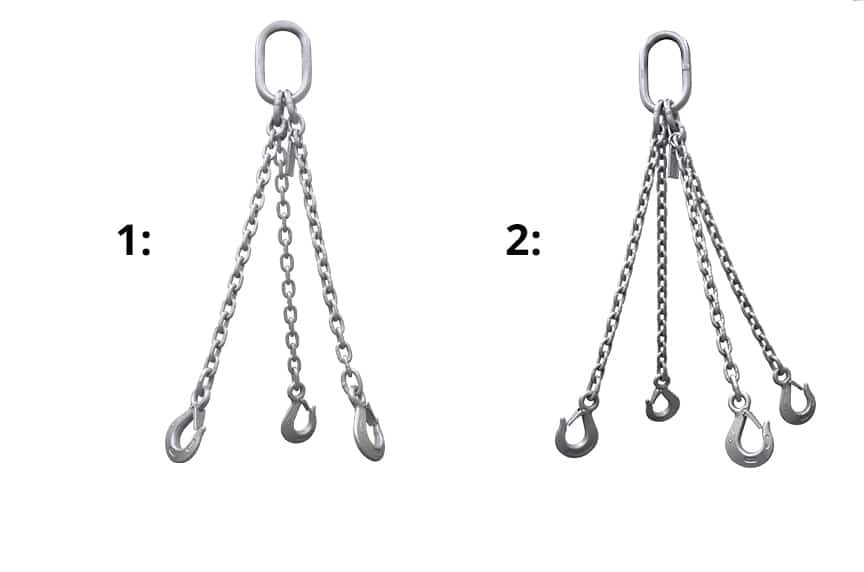
Triple-leg and quadruple-leg chain slings, like all multiple-leg chain slings, will have a collector ring at the top. Let’s go over some examples (see labeled image for number references)
#1 TOS Chain Sling:
T – Triple-leg
O – Collector ring is an oblong master link
S – Lower end fittings are sling hooks
#2 QOS Chain Sling
Q – Quadruple-leg
O – Collector ring is an oblong master link
S – Lower end fittings are sling hooks
Chain Sling Assemblies with Adjusters
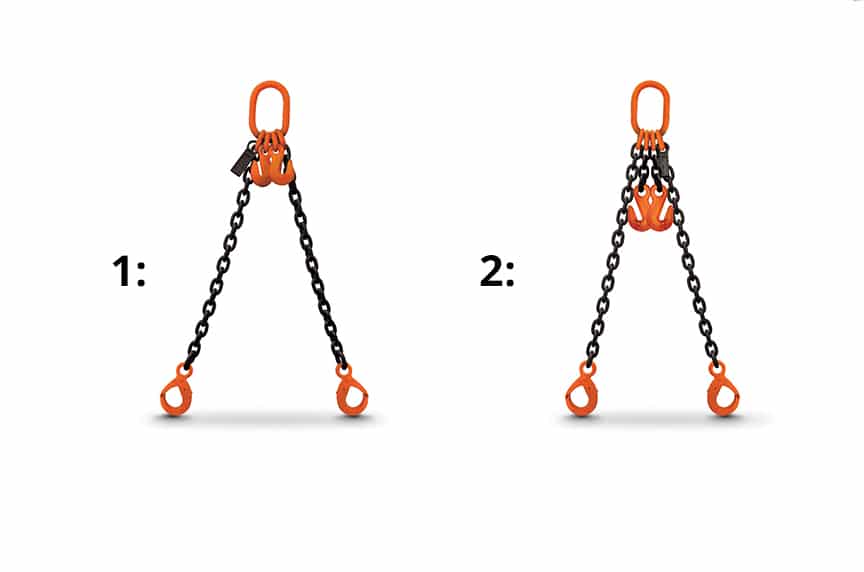
Shorteners—usually grab hooks—may or may not be present on the chain sling assembly. Let’s go over some examples (see labeled image for number references).
#1 DOSA
D – Double-leg
O – Collector ring is an oblong master link
S – Lower end fittings are sling hooks
A – Shorteners are present less than 2 inches from collector ring
#2 DOSB
D – Double-leg
O – Collector ring is an oblong master link
S – Lower end fittings are sling hooks
B – Shorteners are present on a length of chain more than 2 inches from the collector ring
Wrapping It Up
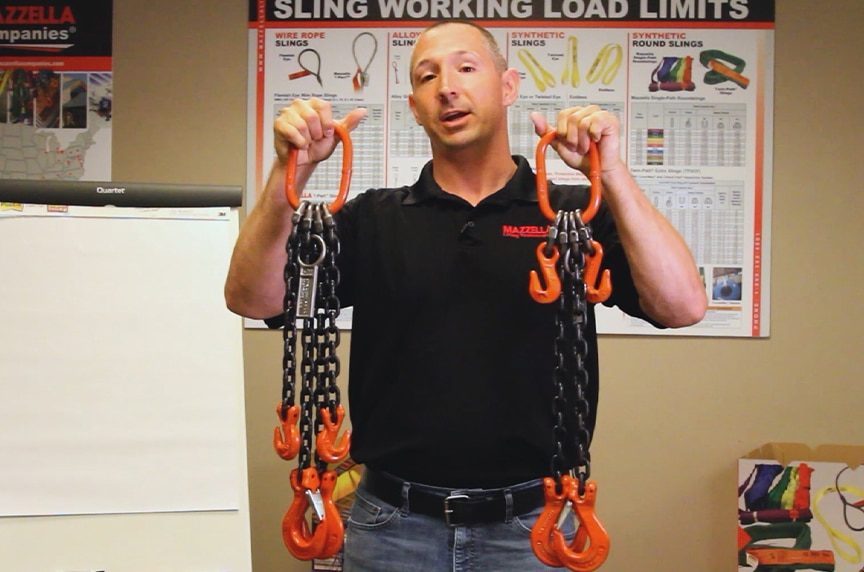
Known for their durability and adjustability, chain slings are a very versatile type of lifting sling that come in a variety of configurations.
The basic parts present on every chain sling assembly are:
- Identification tag
- Upper end fitting – usually a collector ring
- Legs – there can be one, two, three, or four legs on a chain sling assembly
- Lower end fittings – usually hook(s)
There are a few types of collector rings, but the most common type to be used on a chain sling assembly is an oblong master link. The most common hook types used as the lower end fittings on a chain sling assembly are:
- Sling hooks
- Grab hooks
- Foundry hooks
- J-hooks
The acronym system used to abbreviate a chain sling configuration has three to four letters and refers to the basic parts of a chain sling, with the fourth letter representing the optional adjusters.
We hope that this article helped you to understand the basic parts of a chain sling, the configurations, and how the acronym system refers to a chain sling assembly’s unique combination of parts.
At Mazzella, we offer a full line-up of slings and assemblies including wire rope slings, synthetic slings, chain slings, and more. If you are thinking about purchasing a chain sling assembly, contact a Lifting Specialist near you to schedule a consultation.
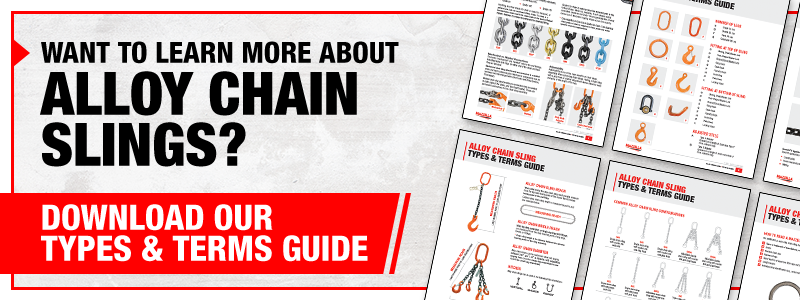

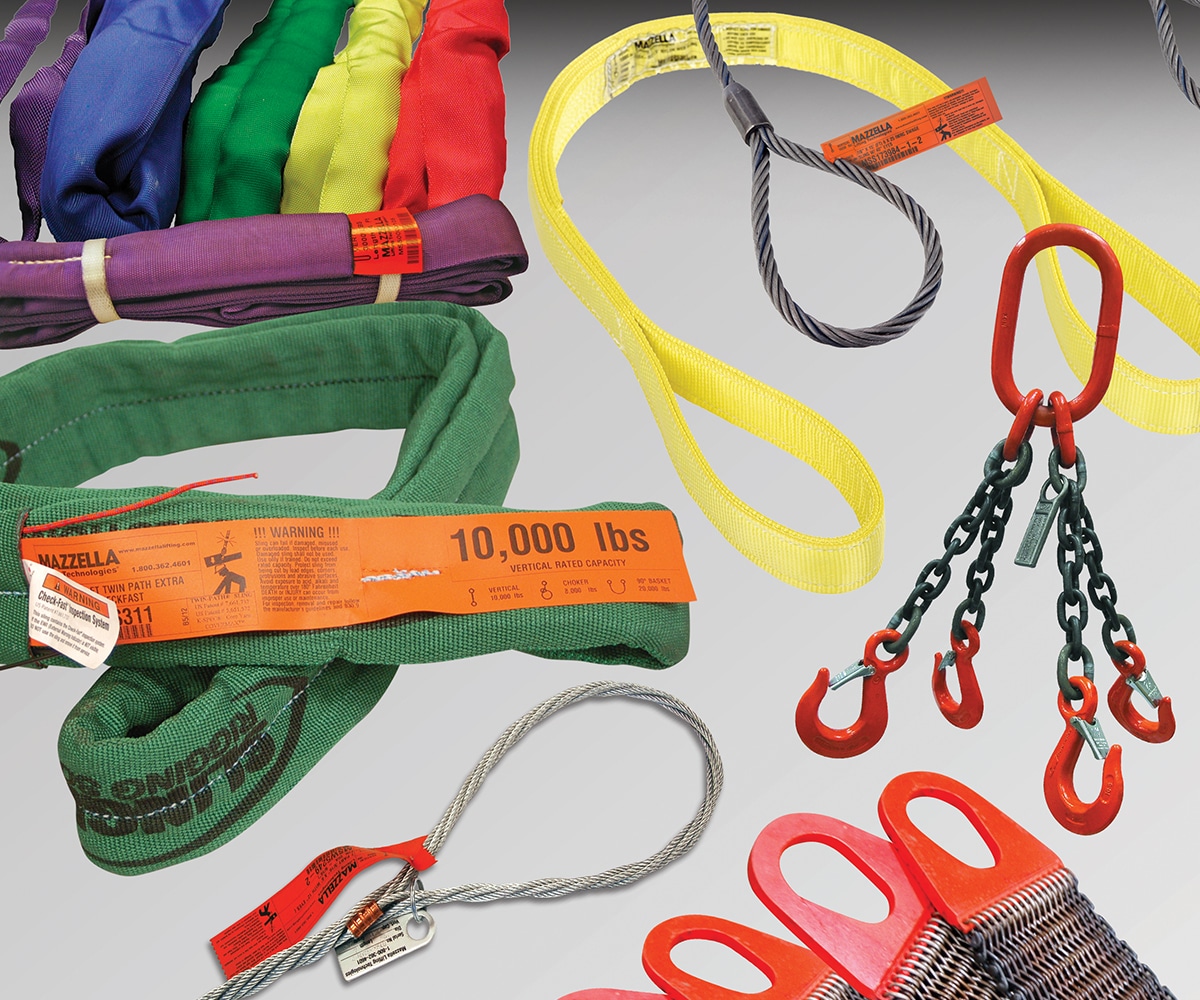
Slings & Assemblies
Are you looking for lifting slings, including chain, wire rope, synthetic flat web, metal mesh, cordage, and single-path / high-performance roundslings? We can help provide the right sling for your needs!
Additionally, if you need sling assemblies—both large and small, we can manufacture bridge cables, crane cables, steel mill cables, and thousands of OEM assemblies.
Contact us today to get the lifting slings and assemblies you need!
Learn more about lifting slings and assemblies!
Copyright 2020. Mazzella Companies.
